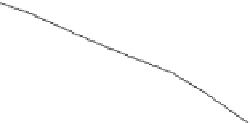Image Processing Reference
In-Depth Information
100
100
80
50
o
o
60
0
40
-50
20
-100
0
50
100
0
50
100
Cyan (%)
Cyan (%)
40
20
M
= 50%;
Y
= 50%
M
= 10%;
Y
= 50%
o
0
o Nominal point
-20
-40
0
50
100
Cyan (%)
FIGURE 7.30
Diagram representing L*a*b* values when C separation is varied at constant
M and Y.
B is the Jacobian matrix computed around the initial CMY value (or measured
using techniques outlined in Ref. [95])
u(k) is the control law applied to the input of the printer
The Jacobian matrix B is different for each node color and computed as follows:
2
3
@
L*
@
C
@
L*
@
M
@
L*
@
Y
4
5
@
a*
@
C
@
a*
@
M
@
a*
@
Y
B
¼
(
7
:
88
)
@
b*
@
C
@
b*
@
M
@
b*
@
Y
The control law is designed using MIMO state-feedback controllers (based on linear
quadratic regulator [LQR] or pole-placement as shown in Chapter 6 or any other
multivariable digital control techniques [96
¼
Ke(k), where e(k)
is the error between the target L*a*b* and the model L*a*b* at iteration k. In pole-
placement design (Chapter 6), the gain matrix K is derived based on the pole values
speci
-
100]). Thus, u(k)
ed such that the closed-loop system model shown in Figure 7.29 is stable. This
is achieved by assigning pole values within the range [0,1) in the Z-domain. For the
loop to be stable, the eigenvalues of the closed-loop system should remain inside
the unit circle of the Z-domain even when the printer drifts. Hence, the pole values






















































































Search WWH ::

Custom Search